WARNING -- THIS ARTICLE IS WRITTEN WITH THE 4TH EDITION WARHAMMER 40,000 RULES IN MIND!!!
INTRODUCTION
an article by Jon "yakface" Regul
This is (hopefully) the first in a series of articles dedicated to discussing the rules of Warhammer 40,000. In particular, the different interpretations players often have of the exact same rule.
The goal of these articles is to help players identify areas in the rules that tend to cause disagreements and resolve those potential issues before their games even begin. This series can also be a useful tool for tournament/campaign organizers by helping them find the issues they may need to make rulings on and what impact those rulings will have on their tournament/campaign games.
LINE OF SIGHT - Model's Eye View vs. The Magic Cylinder
This issue easily represents the most commonly disagreed upon basic rule in the game of Warhammer 40,000 (4th edition). There is rarely a tournament I attend that I do not encounter at least one player who tells me that in their gaming group they play the complete opposite of how I play.
The funny thing is, what is discussed in this article is one of the most fundamental elements of the game (the Line of Sight rules). One would imagine that all players would handle such a core concept exactly the same way, but this has clearly not been the case.
At the very heart of the matter lies the question: Is the process of discerning line of sight in Warhammer 40,000 ultimately a two or three-dimensional concept?
The easiest way to differentiate between these two concepts is to focus on a situation where line of sight is considered "blocked". In either method, "line of sight" is the process of drawing an imaginary line between the firing model and the target enemy model/unit. How and when that line is blocked is the crux of the difference between the two ideals.
The two-dimensional line of sight concept (aka the Magic Cylinder)
A player who believes in the "Magic Cylinder" essentially plays the game of 40K as two-dimensional. The actual physical height of the models and terrain on the table is irrelevant. Only the size classifications assigned to models and terrain matter; and this is done as a convention to represent the concept of height in the game in lieu of ever actually relying upon physical size or elevation.
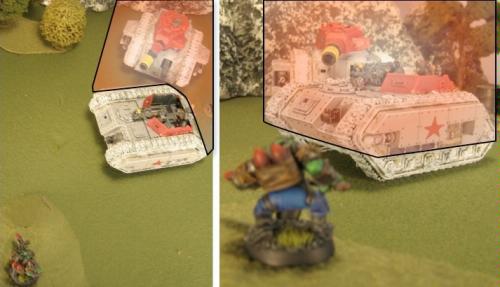
FIGURE A
Because of this, a model or terrain feature that meets the requirements to block line of sight does so completely. The model/terrain feature either has a large enough size classification to block line of sight or it does not. There is absolutely no grey area when trying to determine whether line of sight exists over a model/terrain feature when using this approach (see Figure A).
Even though it physically appears that the firing Ork can draw line of sight to the larger Leman Russ over the smaller Salamander, the intervening Salamander has a size classification of 3, meaning it blocks line of sight completely. Whether or not a model is physically larger than the intervening model/terrain feature is completely irrelevant.
To those players who don't play the game with this approach, the way a physically smaller Salamander blocks line of sight to the larger Leman Russ makes it seem as though an invisible or "magic" cylinder extends above the Salamander blocking line of sight to a physical height of infinity. Hence the name of the playing style.
When playing with a Pure Magic Cylinder approach, the only time a player needs stoop over the table to get a model's eye view is to determine if line of sight can be drawn around another model/terrain feature; the ability to draw line of sight over anything is entirely granted via the size classification system.
The Three-Dimensional Line of Sight Concept (aka a Model's Eye View)
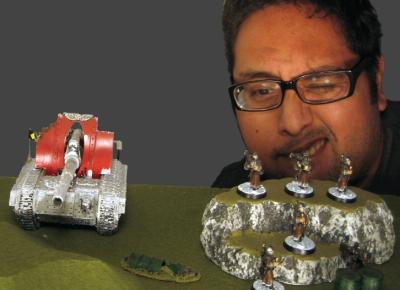
FIGURE B
A player that believes in the 'Model's Eye View' approach plays with line of sight rules that utilize all three physical dimensions of the battlefield including height. Although the two-dimensional size classifications presented in the rule-book are used in select situations (when drawing LOS through area terrain or an ongoing close combat), in most circumstances the physical composition (including the height and elevation) of the models and the terrain is what dictates whether line of sight is blocked or not.
So what exactly is a model's eye view? Although the term has never been defined in Warhammer 40K, it seems to be an offshoot of the basic "eye's view" terminology (such as a "bird's eye view" or a "worm's eye view"). These concepts have the viewer taking the role/angle of the object/creature in order to see the world from the object/creature's point of view. So when the rules dictate to take "a model's eye view" the player should be, to the best of his ability, looking at the table from the point of view of the firing model (see Figure B).
Admittedly, it is impossible to get a 100% true model's eye view, as the player cannot physically get his vision inside of the model. Some players attempt to use tools, such as laser pointers, to accomplish this goal. In fact, the 2nd edition of Warhammer 40K even suggested that some players use periscopes or mirrors to get a model's eye view (2nd edition rule-book; page 26).
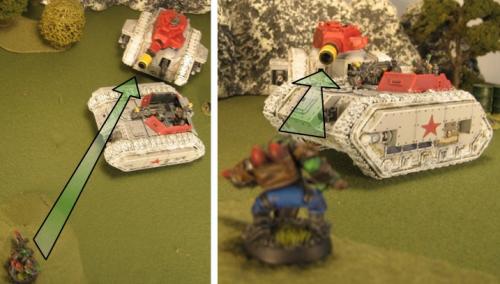
FIGURE C
Regardless of the method used to obtain it, the principle behind a model's eye view remains the same: the player strives to see what the firing model would see were he the model. If the player can physically see the target enemy model/unit over or around intervening terrain and models (not including area terrain and models locked in close combat, which use the size classification rules) then his firing model can see the target and may therefore shoot at it (see Figure C).
This represents the exact same situation as Figure A, but this time in reference to the three-dimensional Model's Eye View approach. In this style of play, the firing model can clearly see the physically larger Leman Russ over the intervening Salamander and may therefore shoot at it.
The History of Line of Sight and the Model's Eye View
While the previous two sections have hopefully defined the fundamental differences between the Magic Cylinder and the Model's Eye View style of play (I'll be delving more into the rules behind each approach later on in the article), some readers may have a rather large question that needs to be answered before I can move on. How do we truly know that to take a "model's eye view" means to look from the model's point of view?
As I mentioned before, the term has never been defined within the game, and the exact phrase doesn't exist in the real world outside of the game for us to reference. Luckily, the game of Warhammer 40K has been around for over fifteen years and has gone through three major re-writes. While the rules for past editions have no direct bearing on the current game, the term "model's eye view" has appeared in the line of sight rules in all four versions, and has been referenced essentially the same way each time. By looking at the term within context of these older editions it becomes clear what is meant by a "model's eye view".
The most important thing to understand about previous editions of the game is that none of them had any sort of abstract size classification system as the 4th edition of the game does. They all left the determination of whether a model had line of sight to its target up to the player's judgment; and that stooping over the table to take a model's eye view was the best possible way to make that determination.
The 2nd edition of the game has the most detailed description of what a model's eye view is (2nd edition rule-book; page 26):
"Usually it will be obvious that a model can't shoot because there is a hill, a building, or some other large and solid object in the way. However, in some cases it is difficult to tell if a line of sight is blocked or not, and players must stoop over the table for a "model's eye view". This is always the best way to determine whether or not a line of sight exists - some players even use small periscopes or mirrors to check the views from their models!"
Even more importantly, both Rogue Trader and 2nd edition make it perfectly clear that a model located on a physically tall piece of terrain naturally gains a better line of sight from being in that elevated position (2nd edition rule-book; page 27):
"By stooping down over the table for a model's eye view it will be obvious that a trooper on the top of a hill or the roof of a building could see over the top of terrain or troops below him. A model positioned on a hill or on the top of a building is therefore able to shoot at targets which would otherwise be obscured from view."
The diagram (also on page 27) further illustrates this fact:
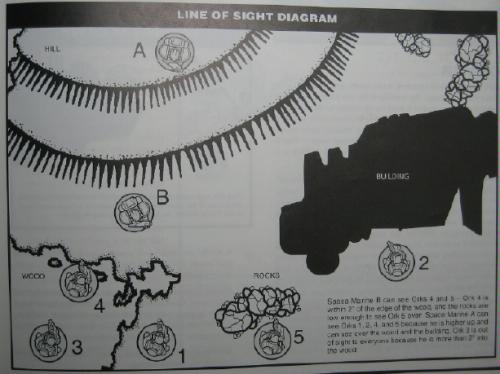
FIGURE D
The caption says:
"Space Marine B can see Orks 4 and 5 - Ork 4 is within 2" of the edge of the wood and the rocks are low enough to see Ork 5 over. Space Marine A can see Orks 1, 2, 4, and 5 because he is higher up and can see over the wood and the building. Ork 3 is out of sight to everyone because he is more than 2" into the wood."
Note that the Space Marine standing on the hill can see over the building because using a model's eye view we know that the Space Marine can physically see the Ork model behind the building. If we only had used the overhead (two-dimensional) view, it would have been impossible to have known that fact.
The Origins of the Magic Cylinder
If it is clear that taking a "model's eye view" means to draw line of sight from the point of view of the firing model, and all four editions use that term, how exactly did the so-called Magic Cylinder style of play come into existence?
From personal experience, despite having played many complete strangers at local gaming stores, I never encountered the Magic Cylinder style of play until the 3rd edition of the game came into existence.
3rd edition was a massive streamlining of the Warhammer 40K rules. Even the sections of the rules that remained fairly similar through the transition ended up being heavily edited (presumably for brevity). The line of sight rules appear to have suffered this fate. While they still told us the best way to determine a line of sight was to use a model's eye view, there was no longer any diagram or description of a firing model in an elevated position, unlike the first two editions of the game.
When you also consider that all the diagrams in 3rd edition were in a top-down (two dimensional) view, it really isn't hard to understand how players new to the game would simply assume that height played absolutely no role in Warhammer 40K. They figured that a model's eye view was only ever used to determine if you could see around terrain features, not over them.
It was at this point in time that I started seeing Rhinos (turned at a 90 degree angle to improve their frontage) being used to block line of sight to the much larger Land Raider model because the rules said (3rd edition rule-book; page 45): "Enemy models and all vehicles block a unit's line of sight if they are in the way, just like buildings and other terrain." To those players who viewed 40K as a two-dimensional game, this terminology meant that every vehicle was essentially a movable, infinitely tall mountain they could use to hide their models behind. Thus, the "Magic Cylinder" was born.
Fast forward to the current (4th) edition of the game. While the changes made to the line of sight rules were promoted as being a clarification, the honest truth is that the division between the two and three-dimensional styles of play is still quite wide. How can so many players read the same rules and come up with a completely different interpretation? What do the Magic Cylinder players see in the rule-book that the Model's Eye View players don't and vice-versa?
The Case for the Magic Cylinder
The following arguments presume that the reader is quite familiar with the 4th edition line of sight rules. If you aren't I suggest re-reading pages 6-7 (base and height guidelines), 17 (area terrain) and 20-21 (line of sight) before continuing.
The heart of the problem lies with the size classification system that was introduced in 4th edition for models and terrain features. While it was reportedly included to help clarify line of sight issues, instead it has honestly helped to fuel the fire.
The main support for the Magic Cylinder style of play in 4th edition is within the 'Model Height' rules on page 7 of the rule-book. The following two sentences are the cornerstones of the Magic Cylinder camp:
"The following categories [Sizes 1, 2 and 3] are the only ones that are important in the Shooting phase when determining line of sight and target priority."
And: "All you need to remember is that if an observer OR the observed is of a greater height category than anything in the way, then it has a clear line of sight."
If the designers did not intend for a fully Magic Cylinder (two-dimensional) line of sight system in 4th edition these two sentences are, without a doubt, very poorly written.
I believe that when some players (especially ones new to the game) read pages 6-7 of the rule-book (where those quotes reside) they then come to the conclusion that 40K is indeed a two-dimensional game. From that point on, all other rules are then interpreted to help support that belief. In order to accomplish this however, a number of rules have to be either ignored or creatively adapted:
- Page 17; Area Terrain: The player has to ignore the fact that only Area Terrain is given a size classification per the rules. They have to give all terrain features a size classification (or play only with Area Terrain). If they do not, there is no way to determine if a firing model can see over a terrain feature if line of sight is determined solely by comparing size classifications.
- Page 20; Line of Sight: The player has to assume that a "model's eye view" is used only to determine if a firing model can see around an intervening object (as opposed to over it), despite the fact that a "bird's eye view" (an overhead look at the table) is a far better way to determine this.
- Page 20; Line of Sight: The player has to assume that the reference to a line of sight being drawn "over" vehicles, vehicle wrecks, monstrous creatures and artillery is an error or is included so players can use house rules to play with models/terrain that are classified larger than size 3.
- Page 21; Line of Sight: The player has to assume that when the rules require that "Line of sight must be drawn to the body of the target model" that they mean a generalized term "body". A term that is actually represented by any area above the base of the target model.
To players who don't believe in the Magic Cylinder this may seem like an unacceptable list of assumptions and creative license, but I think it is important to remember that a wide variety of players do indeed subscribe to the Magic Cylinder theory, including seasoned Grand Tournament veterans. The Dark Eldar tactics article featured in US White Dwarf 309, for example, features advice on using a wrecked Raider to completely obscure line of sight (page 103). This means the author, a longtime 40k player, indeed believes the rules support a Magic Cylinder style of play.
The case for the Model's Eye View
The case for the Model's Eye View style of play is rooted in the line of sight rules (rule-book; pages 20-21) and is unsurprisingly supported by the bulleted issues (listed in the previous section) against the Magic Cylinder. The core argument comes from the following quotes (page 20):
"In some cases it will be difficult to tell if line of sight is blocked or not, so players might have to stoop over the table for a model's eye view. This is the best way to determine whether or not a line of sight exists. The only time you don't use this method is when you want to draw a line of sight into or past Area Terrain, or an ongoing assault combat - this is dealt with later."
And: "All vehicles, vehicle wrecks, monstrous creatures and artillery, friend or foe block line of sight. A line of sight can still be drawn over or past such models, but not through them. Use a model's eye view to determine if you can see past them."
A Model's Eye View player still uses the size classifications, but only in the two distinct cases that the line of sight rules tell us to do so: When line of sight is drawn through close combat (page 20) and when it is drawn into or through area terrain (page 21).
All other times, the line of sight rules tell a player to use a model's eye view, and that this is the best way to determine if a line of sight exists. This means a line of sight can be drawn over such objects as a vehicle or vehicle wreck if the firing model can physically see his target over or around the intervening obstacle.
This method also alleviates the issues highlighted by the Magic Cylinder approach. The "body" of a target is actually the body of the model. Also, not all terrain features need be assigned a size classification because a Model's Eye View can be used to determine if a firing model can see over solid terrain features (like a hill or wall).
Of course, in order to believe in the Model's Eye View approach, a player needs to deal with those two sentences on page 7 of the rule-book that really support the Magic Cylinder. As with the opposite case, some assumptions and creative interpretations are needed:
- When reading (page 7): "The following categories [Sizes 1, 2 and 3] are the only ones that are important in the Shooting phase when determining line of sight and target priority." The Model's Eye View player must assume the sentence refers only to other types of classifications (such as "vehicle", "infantry", "monstrous creature", etc), as opposed to any other factors (such as physical size of the model).
- Concerning the second quote (page 7): "Be aware though that when you want to see over some terrain features or an ongoing close combat, these heights become relevant. All you need to remember is that if an observer OR the observed is of a greater height category than anything in the way, then it has a clear line of sight." The Model's Eye View player must assume that the latter sentence is in reference to the former sentence. This would mean that size classifications only matter when line of sight deals with area terrain or close combats.
The final hurdle for the Model's Eye View approach is the fact that, although the rule-book covers models on area terrain gaining an elevation bonus, it does not have any such stipulation for models standing on non-area terrain, such as a hill (since non-area terrain pieces do not get a size classification).
Luckily, this problem was covered first in a terrain article written by one of the game's authors, Pete Haines, in US White Dwarf 308 (page 95):
"There is one part of the terrain rules that has generated some questions. It involves models standing on other terrain features to get a better view. Standing on elevated terrain is mentioned in the rules, but sadly there is no follow-up guidance on how it works - an omission I am delighted to correct.
Enabling models to stand on terrain for a better view requires some thought before the game. All you need to do is agree beforehand which terrain provides an elevated view. The obvious candidates are hills, towers, and the like. Models enjoying an elevated view should be treated as being Size 3 for determining what they can see over."
That same article (page 94) also supports the Model's Eye View approach by clarifying that there are indeed two types of terrain: WYSIWYG (what you see is what you get) and area terrain. The picture below shows an example of WYSIWYG terrain in the article:
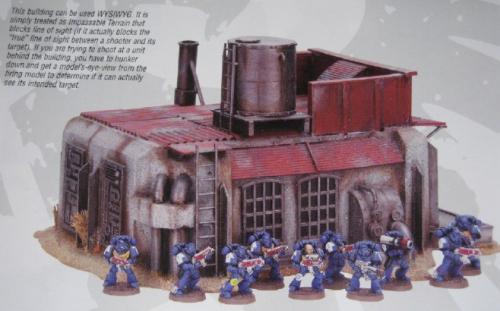
FIGURE E
The caption says: "This building can be used WYSIWYG. It is simply treated as Impassable Terrain that blocks line of sight (if it actually blocks the "true" line of sight between a shooter and its target). If you are trying to shoot at a unit behind the building you have to hunker down and get a model's-eye-view from the firing model to determine if it can actually see its intended target."
The online rule-book FAQ later published by GW further backed up this same position that the game uses both 'true' line of sight in some circumstances and the size classification system in others:
"Q: Does an infantry model on a Size 3 hill count as size 3 or as size 5 (3+2) in regards to LOS into/over Area Terrain and other models? And what about a Size 3 tank on a hill?
A: The size of the hill is not added to the model's size, but rather the model counts as being the same size as the hill. Both models therefore count as Size 3 for the purpose of LOS over Area Terrain and other models. Remember, however, that when working out LOS with normal terrain (not Area Terrain) real line of sight is used, so being on a hill is still an advantage for a tank."
The fact that both sources support the concept that there are two different types of terrain, one of which doesn't get a size classification, is the strongest indication that a purely Magic Cylinder type of game play is not intended by the authors.
The Magic Cylinder vs. the Model's Eye View - Round 2
Up until now, I've discussed the Magic Cylinder vs. the Model's Eye View purely from the standpoint as a philosophy or style of play. However, there is a sub-sect of this argument that divides even more players. That is: exactly what constitutes the boundaries of a "model" when determining how they block line of sight?
This issue stems from the passage on page 7 of the rule-book:
"Firstly, a model is considered to occupy the area of its base, so when measuring distances use the closest edge of the base as your reference point."
For this discussion remember that the line of sight rules on page 21 say:
"A line of sight may be drawn over or past [models that block line of sight], but not through them."
The content of these two sentences combined tend to split players into four distinct camps:
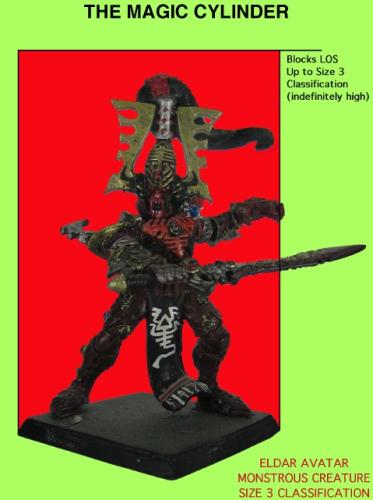
FIGURE F
The Pure Magic Cylinder player
For a Pure Magic Cylinder player a model blocks line of sight as wide as its base and as tall as it's size classification (the area colored red); the model's physical height has no bearing on the game. This is the classic Magic Cylinder player that has been presented so far in this article. According to a poll I conducted on the Dakka forum, about 12% of players play the game this way.
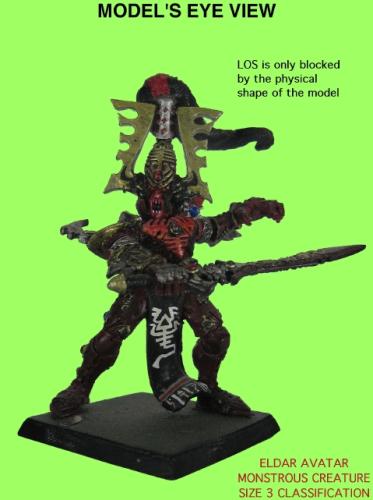
FIGURE G
The Pure Model's Eye View player
To a Pure Model's Eye View player, the model only occupies the area of its base (just the physical dimension of the base itself), not the area above the base. This means only the physical parts of a model that block line of sight actually do so. If a line of sight can be physically drawn around or over the model (including between its legs) to a target, then it does not block line of sight. I have yet to encounter any players who actually play this way, but according to the poll I conducted on the Dakka forum, about 9% of players play the game this way.
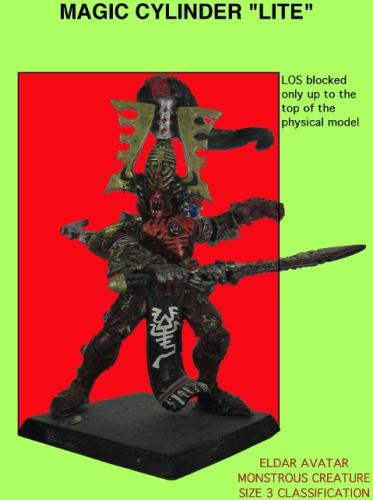
FIGURE H
The Magic Cylinder "Lite" player
The Magic Cylinder Lite, despite the misleading name, is actually a form of the Model's Eye View style described in this article. However there is one important difference (and what gives this style its name): that a model blocks line of sight from the edge of its base up to the top of the physical model (the area colored in red). Any line of sight that crosses this Magic Cylinder is considered blocked even if the target can physically be seen through this area. This is the most common type of player I have personally encountered and according to the poll I conducted on the Dakka forum, 42% of players play the game this way.
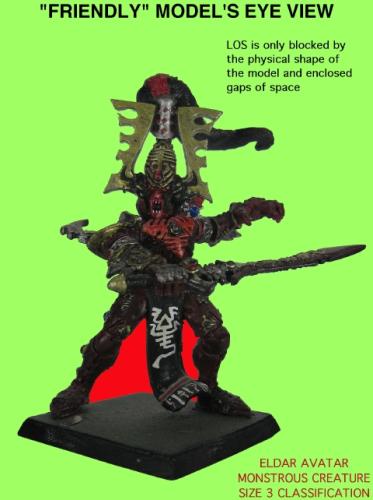
FIGURE I
The Friendly Model's Eye View player
To a Friendly Model's Eye View player the model only occupies the area of its base (just the physical dimension of the base itself), not the area above the base. However, he believes that drawing line of sight between the model's legs (or any other appendage that touches the base/table) essentially counts as firing "through" the model and is therefore not allowed. In essence, this is more of a laid-back approach to the Model's Eye View and is the second most common type of player I have encountered. According to the poll I conducted on the Dakka forum, 37% of players play the game this way.
Game Impact of the Pure Magic Cylinder Style of Play
As you can see, there are actually quite a few different ways to play the line of sight rules in 40K. A tournament organizer or even just a regular player might be wondering what impact playing the game with a certain approach will have on armies and styles of play.
Playing the game in a Pure Magic Cylinder style of play makes determining line of sight much quicker and easier. This in turn tends to make the games themselves shorter. Players will rarely, if ever, have to stoop over the table to take a Model's Eye View, and if they do it will only be to see if they can see around an obstacle and not over it. All decisions regarding if a model can see over an intervening piece of terrain or model are handled by the size classification system, which is pretty clear cut. This means fewer arguments about line of sight between players.
Since the game only contains 3 size classifications, all (non-skimmer) vehicles, wrecks, Monstrous Creatures, Artillery and Size 3 Area Terrain completely block line of sight. That means lines of fire across the board can be very limited, prohibiting those armies based around static shooting and instead favoring fast moving and/or close combat oriented armies (as they have more opportunities to maneuver without being shot at). Imperial Guard, Tau and static shooting Chaos/Space Marine players may complain that this interpretation of the rules unfairly hinders them.
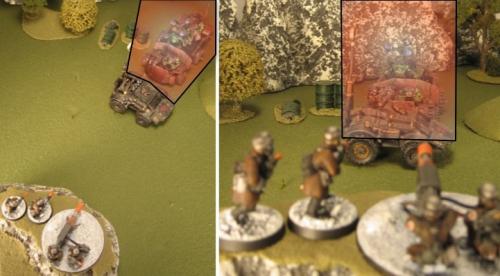
FIGURE J
It also means that screening tactics become a huge part of the game. Turning a Rhino sideways to block line of sight to a Land Raider is common. Light vehicle based armies such as Dark Eldar or the Ork Kult of Speed really benefit as they can use one vehicle as mobile cover to block line of sight to several more transports (see Figure J).
The Ork player has used a buggy to block line of sight from the Imperial Guard to his more valuable Trukks (Note that Dark Eldar have to wait until a skimmer becomes a wreck to use this tactic).
Space Marine Drop Pods also become more potent as it is easier to create a 'wall' that completely blocks the enemy's line of sight where the Space Marine player needs it. [HELP! If you've got a good picture of Space Marine drop pods in a game being used to block LOS, please feel free to add that picture into the article here]
Lastly, although it is less advantageous to abuse the rules through creative modeling with a Pure Magic Cylinder style of play, it is still relatively easy and effective. Players can choose to base their models on over-sized bases in order to make them have a larger cylinder of sight blockage. [HELP! If you've got a good picture of models on gigantic bases being used to block LOS to other models, please feel free to add that picture into the article here]
Tournament organizers who use the Pure Magic Cylinder style of play should consider making additional basing guidelines for their tournament and/or instruct their judges to be on the lookout for players attempting to abuse this rule.
Game impact of the Model's Eye View style of play
Describing how a Model's Eye View style of play impacts the game is a little more difficult as there are the three different sub-sect styles (Magic Cylinder Lite, Friendly Model's Eye View and Pure Model's Eye View) each of which subtly affects game balance. I will stick with the "Friendly Model's Eye View" (Figure I above) for my analysis.
Since players have to spend more time stooping over the table drawing a model's eye view, games will take a bit longer. There will also be more disputes over exactly whether a target is within line of sight as a "model's eye view" is ultimately a subjective concept.
As models can draw a line of sight over Vehicles, Wrecks, Monstrous Creatures Artillery and any non-Area Terrain, this style of play can really favor a static shooting army depending on the density and type of terrain present on the table. The Ork Kult of Speed (and Dark Eldar to a lesser degree) are really hit hard by this playing style as nearly every model will be able to draw a line of sight over their Trukks and Buggies to fire at other Trukks behind. Space Marine Drop Pod armies become slightly weaker as their enemies can shoot across any open space between the pods. [HELP! If you've got a good picture of Space Marine drop pods in a game being used to block LOS, please feel free to add that picture into the article here]
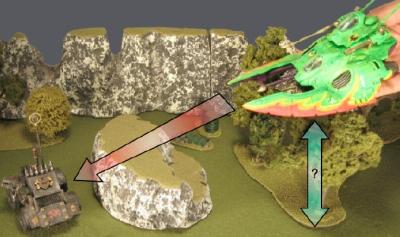
FIGURE N
Veteran Kult of Speed, Dark Eldar, and even Tyranid players may complain that this style of play cripples them, especially those who have based their tactics upon hiding units behind the Magic Cylinder of a vehicle or Monstrous Creature.
Another issue is that the rules do not cover how to draw a "true" line of sight from a Skimmer or Jetbike model that is hovering above Area Terrain, because Area Terrain does not have a defined physical height (See Figure N).
In Figure N, the Eldar Skimmer is hovering over a Size 3 Area Terrain, but wants to fire at the Ork behind the hill. The rules do not tell us how physically high a piece of Area Terrain is, so the Eldar player has no idea from what height to draw a "true" model's eye view from.
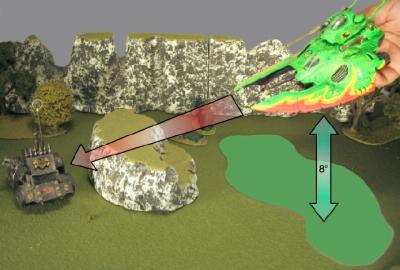
FIGURE O
A tournament organizer using the Model's Eye View style of play should dictate guidelines for this situation. If the tournament has well modeled Area Terrain, players can be told to hold their model directly above the tallest physical portion of the Area Terrain and draw a line of sight from there. If the tournament doesn't have very well modeled Area Terrain a set height could be dictated instead (See Figure O).
In Figure O, the Area Terrain consists of nothing more than a piece of felt. Because of this, the tournament organizer has dictated that a Skimmer or Jetbike hovering over Area Terrain should be considered 8 inches (for example) off the table surface for those circumstances where the player needs to draw a "true" model's eye view from the model over the terrain piece.
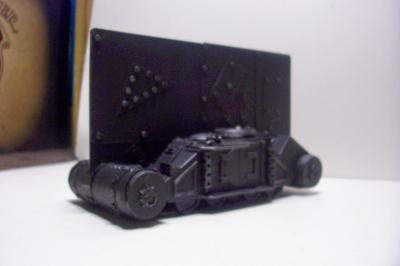
FIGURE P - Looted Rhino Conversion by Krom&krog
A Model's Eye View style of play also leaves a lot of room for players to abuse the rules through creative modeling. Since the rules don't specify the size and shape a model has to be, players are technically free to use converted models of any shape and size. This means a player who wants to make extra large models to hide his other figures behind can do so, such as with Figure P where a player has specifically converted a vehicle in order to allow it block LOS to his other vehicles.
A player who has a large model that excels in close combat can choose to pose the model kneeling or lying down so it can more easily hide behind a hill or vehicle and avoid being shot at. [HELP! If you've got a good picture of models that have been converted specifically to make them easier to hide, please feel free to add that picture into the article here]
However this also means that players who convert their models simply for aesthetic purposes can also unintentionally be penalized. [HELP! If you've got a good picture of models that have been converted dynamically in a way that has unintentionally made them largeer, please feel free to add that picture into the article here]
Tournament organizers who use the Model's Eye View style of play should consider making additional guidelines for creative modeling in their tournament and/or instruct their judges to be on the lookout for players attempting to abuse this rule. A good example of this would be to say that for line of sight purposes, players must use the dimensions of the basic standing GW model (even if that means making a bit of a guess as to how tall a model would be).
Game Impact of the Friendly Model's Eye View vs. the Magic Cylinder Lite
If the vast majority of players (80% of them) play the game in one of these two styles and the split between the two is nearly even (39% for Friendly models eye view and 41% for Magic Cylinder Lite), what is the real game difference between the two styles?
The answer is very little. This slight philosophical difference is most apparent when attempting to draw a line of sight over the edge of a size 3 model's base.
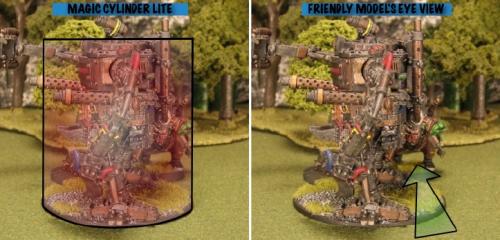
FIGURE T
Since the Magic Cylinder Lite style means that the model blocks line of sight completely across its base up to the physical top of the model, size 3 classification models are much more adept at concealing models behind them than with the Friendly Model's Eye View style of play (See FIGURE T).
This situation tends to occur rather frequently as players often use their size 3 models such as Space Marine Drop Pods and Tyranid Monstrous Creatures to block line of sight to their more vulnerable smaller models. Much like the Pure Magic Cylinder vs. the Model's Eye View comparison, playing with the Magic Cylinder Lite style creates a game with more line of sight blockage which therefore tends to favor assault-based and Drop Pod armies. Alternatively, the Friendly Model's Eye View style tends to favor shooting-based armies that prefer more open lines of sight across the battlefield.
When it comes to players converting their models to gain an in-game advantage, a special note has to be made about the Magic Cylinder Lite style of play. Players are rather easily able to gain an advantage both by altering the size of their model's base and/or by changing the model's height. This gives more opportunities than the Pure Magic Cylinder style (which allows only base size to be altered) and is quite a bit easier to accomplish than with either of the Model's Eye View styles (which require players to create rather extravagant conversions in order to make their models block more lines of sight).
This makes the Magic Cylinder Lite the style most prone to players who wish to gain in-game advantages through creative modeling. Tournament organizers who use the Magic Cylinder Lite style of play should consider making additional basing/height guidelines for their tournament and/or instruct their judges to be on the lookout for players attempting to abuse this rule.
I Get to Make the Call
Although this article is an honest attempt to present both sides of the argument, at the end of the day every player has to make a decision about how they want to play the game of 40K. Being the author, this is the part where I get to explain how I personally make the call on this debate and how I play my games when I have the choice. I'm sure astute readers will have already picked up my natural bias, but I believe that the (Friendly) Model's Eye View is both the better approach and the one more supported by the rules.
Even though the height guideline rules (on page 7 of the rulebook) taken individually seem to support the concept of the Pure Magic Cylinder, there is simply too much evidence to the contrary. Most notably: the terrain article written by Pete Haines (USWD 308) and the GW online rulebook FAQ that both clearly indicate there are two types of line of sight used in 40K 4th edition: A true model's eye view line of sight in most cases, and the 2D size classification system used when encountering Area Terrain or close combat.
Once a player can admit that size classifications are not used to determine line of sight in most circumstances, there can simply be no denying that the line of sight rules (page 20) allow shooting over Vehicles, Vehicle Wrecks, Monstrous Creatures, etc.
While it is undeniable that playing with a Pure Magic Cylinder approach makes determining line of sight simpler and clear-cut, it also turns 40K fully into a two-dimensional game. If the physical size, shape and elevation of the models don't actually matter, we might as well be playing on a 2D terrain mat with labeled flat counters in place of the miniatures.
To me, the whole point of playing a miniatures' based game on a fully modeled table is to get down to the model's eye view and really use the models and terrain to play the game. Seeing a Genestealer poking out from behind the wall and knowing that you get to shoot him because you can see him is much of what makes the game fun.
Do I understand why people like the Pure Magic Cylinder and want to use it? Absolutely. The Pure Magic Cylinder creates fewer arguments, speeds up the game, and doesn't allow as much abuse of creative modeling. But to me, it also makes the game a bit boring. It takes the toy soldier out of the toy soldier game and essentially replaces him with a flat counter. I personally hope the designers never fully turn the game of Warhammer 40K into a two-dimensional game by utilizing a Pure Magic Cylinder approach in all game circumstances.
YOU Make the Call!
As referenced earlier in the article, I posted a poll in the Dakka forums asking players to tell how they play this issue regardless of what they think the 'rules as written' actually say (at the time of writing, over 100 players have cast their votes in this poll).
If you would like to add your voice to this poll click here .
.
Comments and Discussion
Click here to discuss this article or leave comments